Ken Simons: Getting hands-on with priceless art for 40 years
- Published
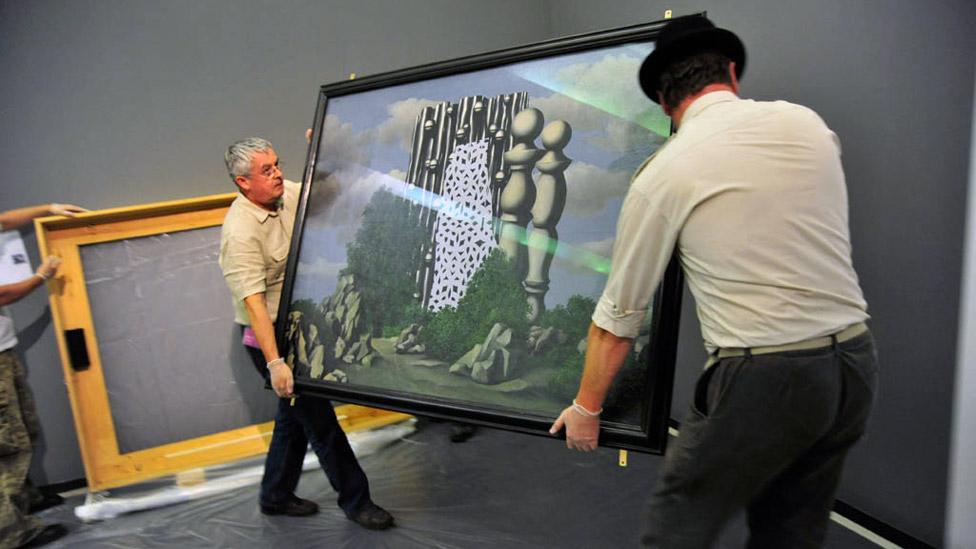
Ken Simons (left) carrying a Magritte
Ken Simons has had his hands on Picasso paintings, moved Tracey Emin's bed and manoeuvred an Antony Gormley sculpture though a third-floor window.
For him, a famous painting or sculpture isn't just a precious creation to be admired - it's a practical puzzle.
Will it fit through the door? How can it be carried? Which trolley is best to wheel it through the gallery? And, in the case of some outlandish modern sculptures - how does it fit together?
As the long-serving art handling manager at Tate Liverpool, these have been Simons' first thoughts when faced with works by the likes of Dali, Rodin, Hockney and Freud.
"I never think of them in terms of value," Simons says. Yet he must have moved and installed art worth billions of pounds over the years.

Simons with the wooden crates that contain the art
He worked at Tate Liverpool from its opening in 1988 until his retirement last summer. Before that, he worked for a decade at the Tate in London.
Now, to mark the Liverpool branch's 30th anniversary, Simons has been allowed to curate his own exhibition - titled Ken's Show - featuring 30 of his favourite works from the Tate collection.
He says his chosen pieces - by JMW Turner, Phillip King, Barbara Hepworth, Mark Rothko, Graham Sutherland and more - "explore the unseen elements of our world".
While his exhibition is on, Simons will also let visitors explore the unseen workings of the gallery itself in a series of tours and talks.
His domain, until he retired, was the loading bay and workshop - the functional, industrial areas that are normally out of sight of visitors to the gentrified former warehouse.
The job of the art handler begins at the heavy metal grille in the loading bay - the gallery's back door - where trucks carrying artworks pull up and disgorge the big wooden crates that contain the art.
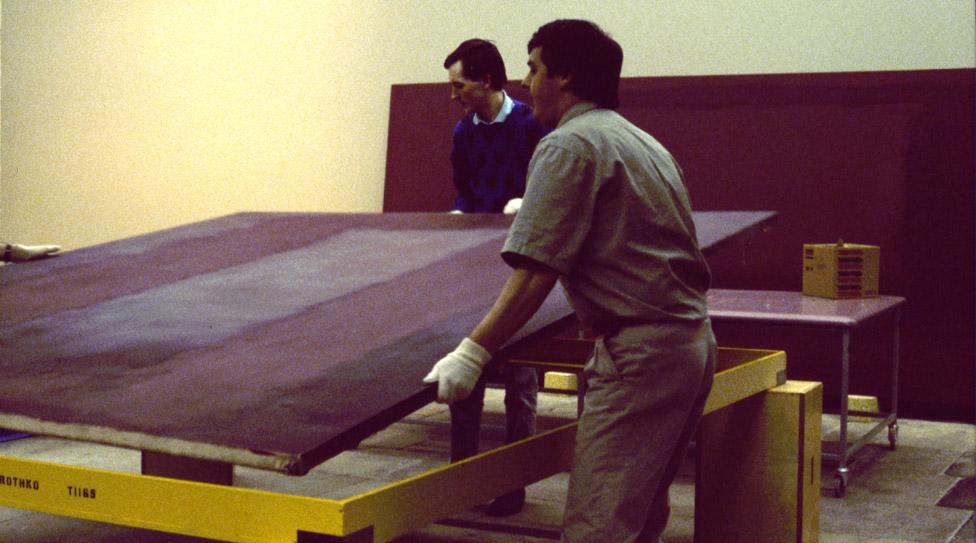
Ken Simons (right) handling a Mark Rothko painting
Simons and his colleagues unpack them - wearing the obligatory latex gloves - and the works are checked for damage.
"Then we're placing them in the galleries with the curators - hanging pictures, setting up sculptures," he explains.
"In contemporary art there are many complicated installation pieces which can take a lot of work, often working with the artists or couriers from abroad.
"So it can be a complex task. And then we go through that process again to take the whole thing out."
The art doesn't always come in and out through the loading bay.
"A few years ago we had Rodin's Kiss in our foyer, which is about three tonnes of marble," Simons says. "We had to have some special struts put underneath the floor to support it.
"We had to take out windows to get it in, and I had to talk to consulting engineers about the buildings because it's an old warehouse and a listed building."
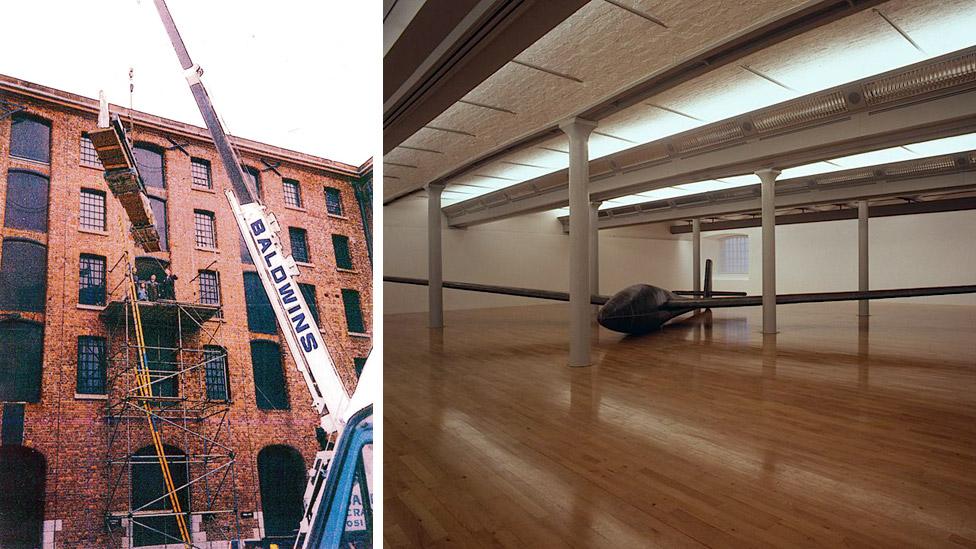
Antony Gormley's Glider was brought in by crane in 1993
The challenges an art handler comes up against can vary radically.
"In the early days, we had an exhibition by Antony Gormley and most of his pieces are made of lead," he says.
"In the exhibition, we had a full-size glider made out of wood then covered in lead sheet. Of course, we had to bring that in in parts - the wings and fuselage - and had to crane it from the outside of the building to get it in.
"Then you get entirely different challenges. We had an exhibition a few years ago by an artist called Nam June Paik. He was one of the first artists to use videos in his pieces.
"His installation involved hundreds of potted plants and in among them were little TV sets. All the cabling and wiring had to be amongst all the plants, and every day we had to water all the plants.
"Another piece of his was a huge aquarium full of fish, so I had to get my team to do training on how to look after fish."
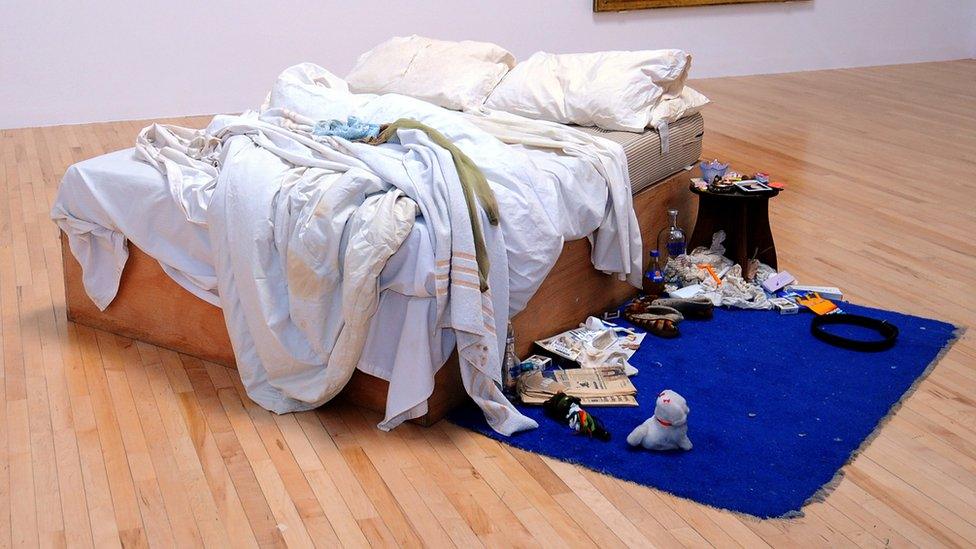
Tracey Emin came to the gallery to arrange her famous My Bed
Complicated sculpture installations usually come with instructions and photos to show how their parts should fit together, like a hideous self-assembly project.
Two years ago, Tate Liverpool hosted Tracey Emin's My Bed: a famously messy, unmade bed accompanied by a floor strewn with used condoms, vodka bottles, cigarette packets and other flotsam from her life.
That work arrived in one piece in a crate, Simons says. "It's part of the deal that Tracey does come and install it itself. She will come and rearrange the bedding as she sees fit.
"We're there helping her unpack it out of the crate, as were our conservators, and they liaise directly with Tracey about exactly how to handle it and position it."
Does the bed comes with a box of used condoms that have to be strewn around once it's in situ? "No, no, no," he replies.

Phillip King's Within (1978-9) has been assembled on site for Simons' exhibition
Working closely with artists is, Simons says, "one of the glories of the job" - normally.
"There's one or two in the past that have been awkward," he admits. "But I'm not going to name names."
Has he ever dropped an artwork? "There have been near occasions - but never, no."
That should be no surprise given the meticulous procedures he describes for handling these works. "We have very strict methods of how to handle things," he adds.
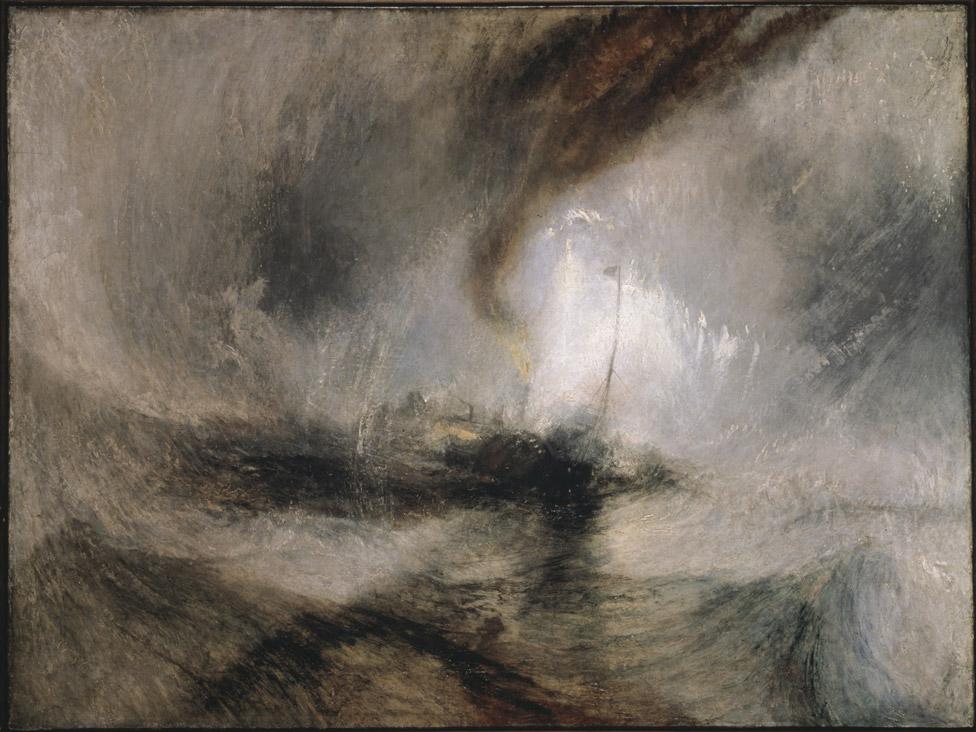
JMW Turner's Snow Storm - Steam-Boat off a Harbour's Mouth is also in the show
The biggest mishap he's willing to admit to is that the alabaster base of Jacob Epstein's Jacob and the Angel got a small chip when it was unloaded in the early years of Tate Liverpool.
But that, he says, was down to the way it had been loaded at the other end.
"That involved lots of writing reports about how this had happened," he says. "Subsequently our conservation [team] designed a different way of handling it." It was also given a permanent plinth.
The procedures were improved, and the gallery's art remained in safe hands.
Ken's Show: Exploring the Unseen runs at Tate Liverpool from 30 March to 17 June.

Follow us on Facebook, external, on Twitter @BBCNewsEnts, external, or on Instagram at bbcnewsents, external. If you have a story suggestion email entertainment.news@bbc.co.uk, external.